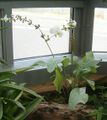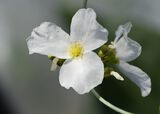Aquarius glaucus (Rataj) Christenh. & Byng

Basionym of : Echinodorus glaucus Rataj
Synonym : Echinodorus teretoscapus R.R.Haynes & Holm-Niels.[1]
Occurrence:
Brazil and eastern Bolivia.
Ecology
Pantanal wetland at an altitude of approx. 100m.
Morphology General habit
Perennial, from rhizomes, glabrous, up to 250 cm
Morphology Leaves
Leaves emersed, with bluish-green wax coating, blade ovate to lanceolate, 7 - 14-veined, 17 - 35 cm long, 7 - 18 cm wide, pellucid markings absent, apex round-pointed, base cordate, petiole round, 30 - 100 cm long, 0.5 - 1 cm diameter, base with sheath up to 8 cm long
Morphology Reproductive morphology Fruits
Fruit transversely lanceolate, 4 - 5-ribbed, keeled, glandular, 2.2 - 3 mm long, 1 mm wide, glands 2 - 3, separated by ribs, circular, beak end, erect, c. 0.5 mm.
Morphology Reproductive morphology Inflorescences
Inflorescence paniculate or racemose, 6 - 14 whorls, each 6 - 17-flowered, erect, protruding leaves, non-propagative, up to 60 cm long, up to 30 cm wide, rachis round, pedicels round, up to 95 cm long, 7 mm diam., bracts free, coarse, deltoid, 0.6 - 1.8 cm long, 4 - 7 mm wide, 18 - 27-veined, apex acute, pedicels spreading in flower and fruit, 1 - 1.8 cm long, 1 mm diam. flowers 3 - 6 cm in diameter, sepals erect, 15 - 32 veined, c. 5 mm long and c. 4 mm wide, veins without papillae, petals spreading, without claws, overlapping, c. 23 mm long, c. 12 mm wide, stamens 24 - 30, anthers many-sided, c. 2 mm long, filaments c. 2 mm long, carpels numerous
Note
Haynes & Holm-Nielsen (1994) synonymized Echinodorus glaucus with E. paniculatus, but redescribed the taxon as E. teretoscapus. Echinodorus glaucus and E. cylindicus are covered with bluish wax, which is usually not preserved in the herbarium, making identification difficult. Both species have large flowers with up to 30 stamens. These species can be distinguished by the broader and heart-shaped leaves of E. glaucus compared to the elliptical leaves with attenuated, blunt base of E. cylindricus.[1]
Phenology
Flowering and fruiting from October to April.
-
Echinodorus glaucus Rataj[2]
-
Echinodorus glaucus Rataj[3]
-
Echinodorus glaucus Rataj[2]
-
Echinodorus glaucus Rataj[4]
-
Echinodorus glaucus Rataj[4]
- ↑ 1.0 1.1 POWO (2021). "Plants of the World Online. Facilitated by the Royal Botanic Gardens, Kew. Im Internet veröffentlicht; http://www.plantsoftheworldonline.org/ Abgerufen am 22. August 2021."
- ↑ 2.0 2.1 BotBln - Own work
- ↑ Kostiantyn Loboda, Black Water http://echinodorus.com.ua/
- ↑ 4.0 4.1 Krzysztof Ziarnek, Kenraiz - Own work





